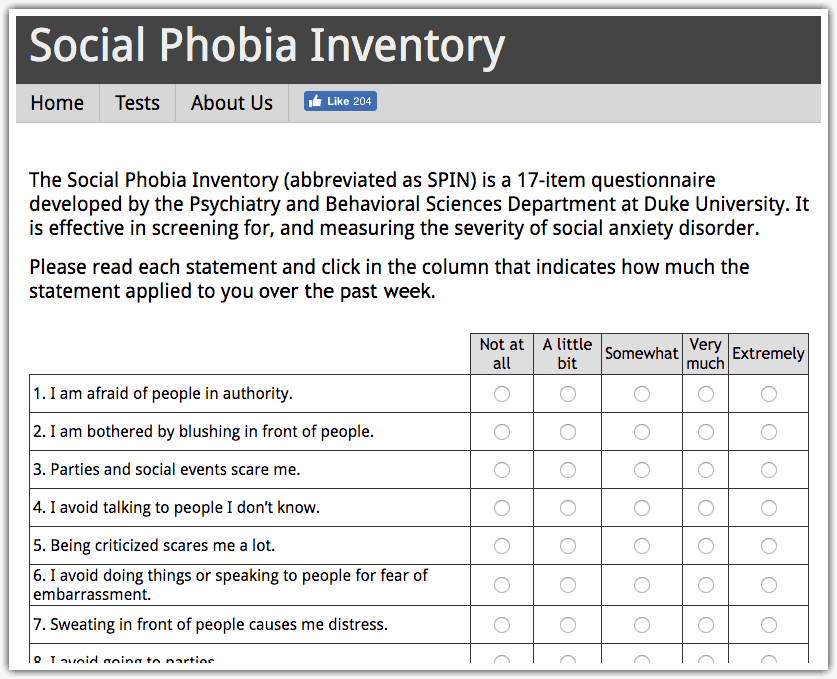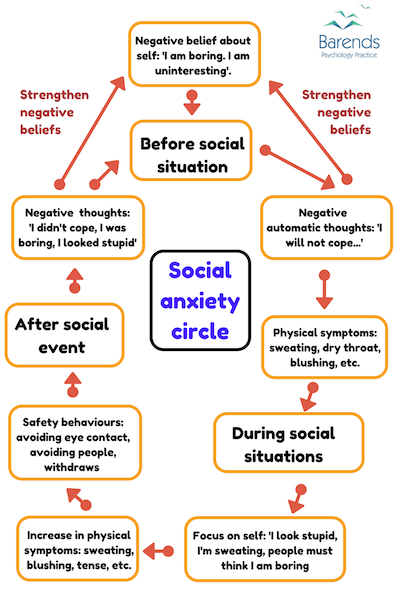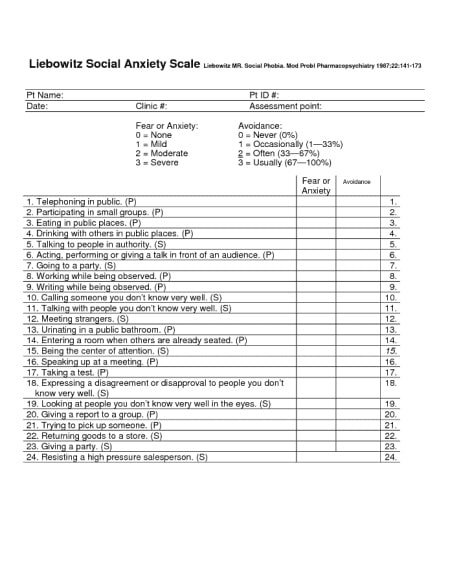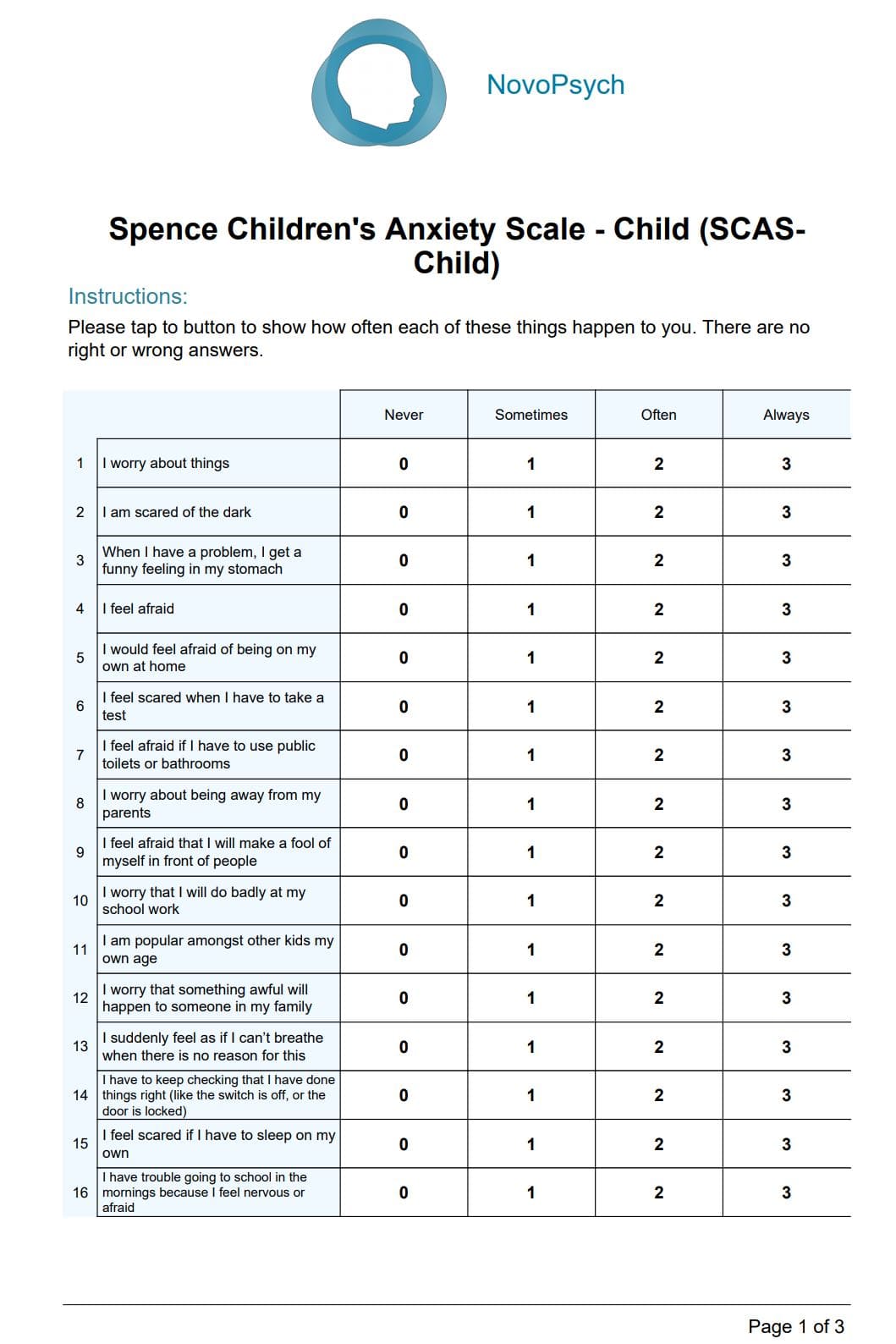Social Anxiety Test
How can a social anxiety test be used to diagnose early signs of this issue?
Gawish, A (2023, February 14). Social Anxiety Test. Retrieved from https://www.structural-learning.com/post/social-anxiety-test
How can a social anxiety test be used to diagnose early signs of this issue?
Gawish, A (2023, February 14). Social Anxiety Test. Retrieved from https://www.structural-learning.com/post/social-anxiety-test
A social anxiety test is a tool used to help measure and identify symptoms of social anxiety disorder. It is administered by qualified clinicians and assesses signs of extreme or pathological levels of shyness, fear or discomfort in social situations.
The questions in the test range from traits like having difficulty making eye contact with others to feeling embarrassed or self-conscious when talking with people. The test results can help diagnose an individual's level of social anxiety, allowing for the development of an effective treatment plan for those who suffer from this condition.
Social anxiety is classified as a mental health condition. It can be caused by various factors, including genetics, environment, and trauma. Although the exact cause is unknown, it's important to note that social anxiety disorder is treatable and can be managed with the help of a professional mental health expert. In addition to taking a social anxiety test, talking about your feelings and concerns with a qualified therapist can help you conquer your anxieties.
It's important to remember that no two people experience social anxiety in the same way. If you're concerned about your mental health, it's best to talk to a healthcare provider or therapist who can assess your concerns and help you decide whether a social anxiety test is appropriate for you. They will be able to work with you on an individual basis to find the right therapy, medication, or lifestyle changes that can lead to improved mental health.
Following the worldwide COVID pandemic, many people are dealing with social anxiety. People are dealing with a wide range of real-world issues and situations. The circumstances vary from person to person and seem trivial to us. But it might result in significant issues. An outline of social anxiety will be provided in this article.
One of the most widespread mental health problems is anxiety. A person's emotional, psychological, and social well-being are all considered to be indicators of their mental health. It involves our attitudes, emotions, and behaviours. Our mental health enables us to recognise our skills and manage stress. In every stage of our lives, from childhood to death, mental wellness is crucial.
Anxiety is one of the mental health disorders, as was already noted. You may occasionally think, "Oh, I'm feeling anxious," and then you may ask, "Should I see a therapist?" Does it have the possibility of affecting me ? We frequently wonder about all of these things.
So, what is anxiety? Anxiety is a discomforting feeling that might be mild or severe, such as worry or fear. When we are anxious, we experience both emotional and physical symptoms. The majority of people nowadays experience anxiety, especially in light of how challenging modern life has become.
Anxiety is a common emotion that affects everyone regularly. An exam, a medical checkup, or a job interview, for instance, could cause you to feel anxious and worried. It is therefore normal to feel anxious at these times. Additionally, it can help in the person's preparation for the interview or the test. Anxiety has not been a problem up to this point, but when it negatively affects a person's life, it can turn into a problem.
Now, we will go further about anxiety and discuss the types of Anxiety.
After giving a brief review of anxiety and its various forms, we'll focus on social anxiety, which is an important type of anxiety.
The majority of people today lead two lives: one offline and one online. It turned out to be a challenging and stressful time, in my perspective. They might be connected to a lot of people on social media sites. But in reality, people frequently struggle to form meaningful social interactions. Instead of meeting in person, people get connected behind the screen.
People who have social anxiety are always afraid of what other people will think of them. A common result of this is social exclusion and avoidance. The issue of social anxiety is particularly common.
Although it might start in early childhood, social anxiety can occur at any age. A young person may experience anxiety, particularly when they begin to reflect on who they are and what they believe. The child's thinking at this point will reflect who they will become later.
Social anxiety has grown as a result of children and teenagers using of social media more frequently. A child's self-esteem is significantly impacted by social media, which can also lead to phobias or feelings of social anxiety.
The term "social phobia" refers to an Intense fear of embarrassment or rejection by others. People with social anxiety disorder frequently have a fear of social situations and find it awkward to attend work, school, or other social events.
It's normal to feel anxious when speaking in front of an audience, such as when giving a speech or participating in a meeting.
However, social phobia is a lot more severe than mild shyness or the typical anxiety. The issue with social anxiety is that you start to actively avoid social interactions because you are so afraid of being embarrassed or judged. That indicates that your level of anxiety is no longer a normal feeling and has started to interfere with your everyday life routines.

We occasionally experience anxiety and shyness, which happens to everyone occasionally. So, as you read this article, consider a circumstance in which you felt shy.
Let's now discuss how shyness and social anxiety differ from one another.
Thus, you could evaluate whether a behaviour is a result of shyness or anxiety.
Shyness refers to the sensation of being uncomfortable in social situations. Even if a person is shy, he or she can motivate themselves to interact with others when necessary. So, for example, if I am afraid about speaking in public, I can still go to work and interact with my coworkers. As a result, shyness has an no negative impact on a person's quality of life unlike social anxiety disorder.
Contrarily, social anxiety is the sensation of being self-conscious when interacting with others. The individual is afraid of being criticised and disapproved by others. Consequently, the person might escape natural life events. Therefore, the individual can decide not to go to work or on a date.
You can view this quick animated movie about social anxiety. This film may be useful because it represents the emotions of a person with social anxiety disorder.
https://www.youtube.com/watch?v=L7u2v8PxXT4

Hopefully, the article has given you a general perception of social anxiety.
Let us now look at the symptoms of anxiety.
There are three parts to social anxiety symptoms: Physical symptoms relate to how we feel; emotional symptoms apply to how we think; and behavioural symptoms connect to what you do.

Similar to other mental health issues, social anxiety can have either a genetic or environmental cause.
There are some different ways that can be used by the mental health professional to diagnose social anxiety disorder. In this part we will discuss those ways.
Healthcare professionals may carry out a number of tests, including the following, to check if the anxiety symptoms are unrelated to a medical conditions:
A link to the Social Anxiety Test (self-evaluation) is also provided here. Although it isn't an official test, you might wish to try it out while reading.
https://www.psycom.net/social-anxiety-test
Interpreting the results of a social anxiety test can be a nuanced process, requiring an understanding of both the psychological and physiological symptoms that manifest in various situations. Here's a list of ways to interpret and utilize the results:
An example might be a teenager who experiences extreme anxiety in social situations, leading to avoidance of school. The test results could guide a therapist in developing a gradual exposure therapy plan, tailored to the specific triggers.
Understanding the intricate web of psychological and physiological symptoms is key to effective intervention in social anxiety.
A relevant statistic to consider is that social anxiety affects about 7% of the population, making it essential to understand and utilize these tests effectively.
Summary:

How social anxiety affects a person's daily activities will determine the most effective treatment approach. Psychotherapy, medicine, or maybe a combination of both is one of the most popular therapies for social anxiety disorder.
Here are some videos that discuss anxiety management techniques:
https://www.youtube.com/watch?v=30VMIEmA114
https://www.youtube.com/watch?v=q3ZkuwabZyQ
I hope to have provided you with an overview of social anxiety disorder by the end of this article.
Each of us may be suffering from a disorder that makes it difficult for us to go through our regular lives.
Nobody on the world is in perfect mental health.
There have always been conflicting emotions, including love, hate, jealousy, fear, worry, and happiness since the world was first created. It's crucial to understand what we go through and always find a way to accomplish our route.
It's not the end of the world to experience social anxiety. But in order to prevent it from affecting our life, the individual needs to face it and deal with it.
A social anxiety test is a tool used to help measure and identify symptoms of social anxiety disorder. It is administered by qualified clinicians and assesses signs of extreme or pathological levels of shyness, fear or discomfort in social situations.
The questions in the test range from traits like having difficulty making eye contact with others to feeling embarrassed or self-conscious when talking with people. The test results can help diagnose an individual's level of social anxiety, allowing for the development of an effective treatment plan for those who suffer from this condition.
Social anxiety is classified as a mental health condition. It can be caused by various factors, including genetics, environment, and trauma. Although the exact cause is unknown, it's important to note that social anxiety disorder is treatable and can be managed with the help of a professional mental health expert. In addition to taking a social anxiety test, talking about your feelings and concerns with a qualified therapist can help you conquer your anxieties.
It's important to remember that no two people experience social anxiety in the same way. If you're concerned about your mental health, it's best to talk to a healthcare provider or therapist who can assess your concerns and help you decide whether a social anxiety test is appropriate for you. They will be able to work with you on an individual basis to find the right therapy, medication, or lifestyle changes that can lead to improved mental health.
Following the worldwide COVID pandemic, many people are dealing with social anxiety. People are dealing with a wide range of real-world issues and situations. The circumstances vary from person to person and seem trivial to us. But it might result in significant issues. An outline of social anxiety will be provided in this article.
One of the most widespread mental health problems is anxiety. A person's emotional, psychological, and social well-being are all considered to be indicators of their mental health. It involves our attitudes, emotions, and behaviours. Our mental health enables us to recognise our skills and manage stress. In every stage of our lives, from childhood to death, mental wellness is crucial.
Anxiety is one of the mental health disorders, as was already noted. You may occasionally think, "Oh, I'm feeling anxious," and then you may ask, "Should I see a therapist?" Does it have the possibility of affecting me ? We frequently wonder about all of these things.
So, what is anxiety? Anxiety is a discomforting feeling that might be mild or severe, such as worry or fear. When we are anxious, we experience both emotional and physical symptoms. The majority of people nowadays experience anxiety, especially in light of how challenging modern life has become.
Anxiety is a common emotion that affects everyone regularly. An exam, a medical checkup, or a job interview, for instance, could cause you to feel anxious and worried. It is therefore normal to feel anxious at these times. Additionally, it can help in the person's preparation for the interview or the test. Anxiety has not been a problem up to this point, but when it negatively affects a person's life, it can turn into a problem.
Now, we will go further about anxiety and discuss the types of Anxiety.
After giving a brief review of anxiety and its various forms, we'll focus on social anxiety, which is an important type of anxiety.
The majority of people today lead two lives: one offline and one online. It turned out to be a challenging and stressful time, in my perspective. They might be connected to a lot of people on social media sites. But in reality, people frequently struggle to form meaningful social interactions. Instead of meeting in person, people get connected behind the screen.
People who have social anxiety are always afraid of what other people will think of them. A common result of this is social exclusion and avoidance. The issue of social anxiety is particularly common.
Although it might start in early childhood, social anxiety can occur at any age. A young person may experience anxiety, particularly when they begin to reflect on who they are and what they believe. The child's thinking at this point will reflect who they will become later.
Social anxiety has grown as a result of children and teenagers using of social media more frequently. A child's self-esteem is significantly impacted by social media, which can also lead to phobias or feelings of social anxiety.
The term "social phobia" refers to an Intense fear of embarrassment or rejection by others. People with social anxiety disorder frequently have a fear of social situations and find it awkward to attend work, school, or other social events.
It's normal to feel anxious when speaking in front of an audience, such as when giving a speech or participating in a meeting.
However, social phobia is a lot more severe than mild shyness or the typical anxiety. The issue with social anxiety is that you start to actively avoid social interactions because you are so afraid of being embarrassed or judged. That indicates that your level of anxiety is no longer a normal feeling and has started to interfere with your everyday life routines.

We occasionally experience anxiety and shyness, which happens to everyone occasionally. So, as you read this article, consider a circumstance in which you felt shy.
Let's now discuss how shyness and social anxiety differ from one another.
Thus, you could evaluate whether a behaviour is a result of shyness or anxiety.
Shyness refers to the sensation of being uncomfortable in social situations. Even if a person is shy, he or she can motivate themselves to interact with others when necessary. So, for example, if I am afraid about speaking in public, I can still go to work and interact with my coworkers. As a result, shyness has an no negative impact on a person's quality of life unlike social anxiety disorder.
Contrarily, social anxiety is the sensation of being self-conscious when interacting with others. The individual is afraid of being criticised and disapproved by others. Consequently, the person might escape natural life events. Therefore, the individual can decide not to go to work or on a date.
You can view this quick animated movie about social anxiety. This film may be useful because it represents the emotions of a person with social anxiety disorder.
https://www.youtube.com/watch?v=L7u2v8PxXT4

Hopefully, the article has given you a general perception of social anxiety.
Let us now look at the symptoms of anxiety.
There are three parts to social anxiety symptoms: Physical symptoms relate to how we feel; emotional symptoms apply to how we think; and behavioural symptoms connect to what you do.

Similar to other mental health issues, social anxiety can have either a genetic or environmental cause.
There are some different ways that can be used by the mental health professional to diagnose social anxiety disorder. In this part we will discuss those ways.
Healthcare professionals may carry out a number of tests, including the following, to check if the anxiety symptoms are unrelated to a medical conditions:
A link to the Social Anxiety Test (self-evaluation) is also provided here. Although it isn't an official test, you might wish to try it out while reading.
https://www.psycom.net/social-anxiety-test
Interpreting the results of a social anxiety test can be a nuanced process, requiring an understanding of both the psychological and physiological symptoms that manifest in various situations. Here's a list of ways to interpret and utilize the results:
An example might be a teenager who experiences extreme anxiety in social situations, leading to avoidance of school. The test results could guide a therapist in developing a gradual exposure therapy plan, tailored to the specific triggers.
Understanding the intricate web of psychological and physiological symptoms is key to effective intervention in social anxiety.
A relevant statistic to consider is that social anxiety affects about 7% of the population, making it essential to understand and utilize these tests effectively.
Summary:

How social anxiety affects a person's daily activities will determine the most effective treatment approach. Psychotherapy, medicine, or maybe a combination of both is one of the most popular therapies for social anxiety disorder.
Here are some videos that discuss anxiety management techniques:
https://www.youtube.com/watch?v=30VMIEmA114
https://www.youtube.com/watch?v=q3ZkuwabZyQ
I hope to have provided you with an overview of social anxiety disorder by the end of this article.
Each of us may be suffering from a disorder that makes it difficult for us to go through our regular lives.
Nobody on the world is in perfect mental health.
There have always been conflicting emotions, including love, hate, jealousy, fear, worry, and happiness since the world was first created. It's crucial to understand what we go through and always find a way to accomplish our route.
It's not the end of the world to experience social anxiety. But in order to prevent it from affecting our life, the individual needs to face it and deal with it.